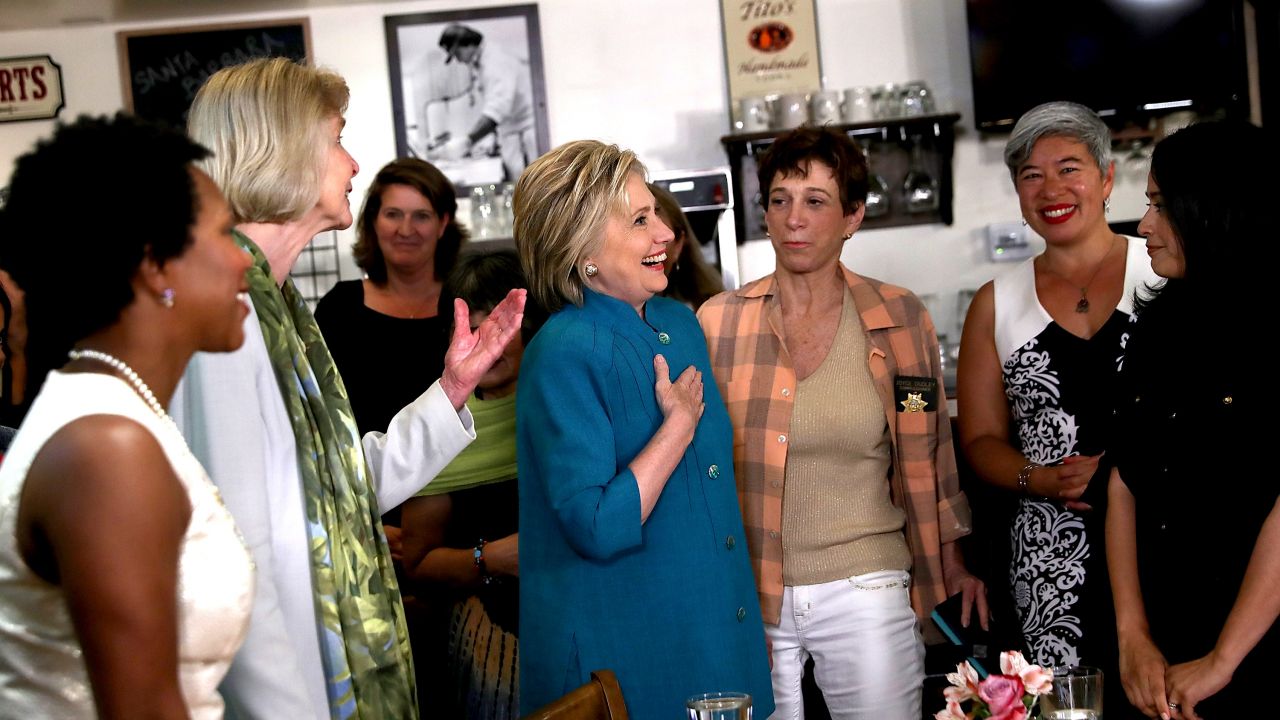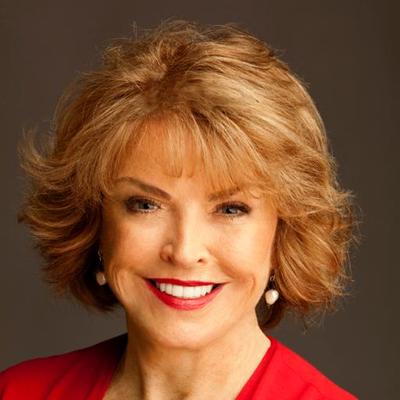
Democratic presidential candidate and former Secretary of State Hillary Clinton greets supporters during a conversation with women and families at Jill's Place on June 4, 2016 in Santa Barbara, California. (Photo by Justin Sullivan/Getty Images)
Over the weekend, Iceland’s voters went to the polls to elect their first new president in 20 years. In a year in which outsider candidates in many countries are finding political success, history professor Guðni Jóhannesson won the race with 39 percent of the vote. But the biggest surprise of the day was the strong showing of second-place finisher Halla Tómasdóttir, one of four women in the race. One wonders if Iceland’s campaigns lasted as long as America’s how far she might have gone: Tómasdóttir entered the race late, polled as low as 1 percent in May but saw a steady uptick in support until election day. She ended up with nearly 29 percent of the vote.
While 2016 saw a US milestone with the presumptive nomination of Hillary Clinton, in Iceland, a woman on the ballot is not such a big deal. Nearly half of this year’s nine-candidate presidential field was female. This near-parity among genders on the Icelandic ballot isn’t all that surprising — according to the World Economic Forum, for several years running, the country has ranked No. 1 for gender equality in the world. Although Iceland’s presidency is largely a ceremonial role, the country also recently elected its first female prime minister, Johanna Sigurðardóttir (2009–13), a social democrat and a 66-year-old lesbian – the world’s first openly gay premier. Moreover, Iceland has institutionalized this egalitarianism through its Ministry of Gender Equality, a government agency that works to “establish and maintain equal status and equal opportunities for women and men, and thus promote gender equality in all spheres of the society.”

Vigdis Finnbogadóttir (left), the President of Iceland, meets British Prime Minister Margaret Thatcher at Number 10 Downing Street in London, Feb. 17, 1982. (Photo by Mike Stephens/Central Press/Getty Images)
As far back as 1980, Iceland was the first country in the world to democratically elect a woman president. And she was popular, too: Vigdís Finnbogadóttir, a divorced single mother, served 16 years until she decided to step down, making her the longest-serving elected female head in any country, ever. Today, women make up about 40 percent of Iceland’s parliament and ministerial positions.
But it wasn’t always this way in Iceland. This change in national perceptions about gender and leadership required a real fight.
Women gained the right to vote in Iceland in 1915. It was only the third country to allow it, behind New Zealand and Finland. Despite this progressivism, few women held positions in Iceland’s government. By the mid-1970s, there were just three women members of parliament, constituting only 5 percent of the body. Other Nordic countries averaged 16 to 23 percent, and it was a cause of frustration for many in Iceland.
But it wasn’t always that way. This change in Icelandic national perceptions required a real fight.
Five years before Finnbogadóttir ran for president, the United Nations proclaimed 1975 the International Year of the Woman. As in many countries, a number of Icelandic women’s organizations formed a committee to plan commemorative events. At their very first meeting, one woman asked, “Why don’t we just all go on strike?” She and others argued that a “day off” for women could be a “powerful way of reminding society of the role women play in its running, their low pay, and the low value placed on their work inside and outside the home.”
On Oct. 24, 1975, 90 percent of Icelandic women participated in work stoppages. School was cancelled. Fathers brought their kids to work. Some 25,000 women marched on Reykjavik, listened to speeches and rallied in the streets.

“The rally lasted for two hours and was a tremendous success. There were various speakers, including two women members of Parliament who urged women to take a more active part in politics.” (Scandinavian Review, nr. 3, 1977, pp. 60-64.)
Finnbogadóttir credits her election victory five years later to the activism of that day. “After Oct. 24, women thought it was time a woman became president,” she says. “The finger was pointed at me and I accepted the challenge.”
The legacy of the 1975 walkout still resonates in this year’s Icelandic election. Runner-up Halla Tómasdóttir remembered the day clearly in a TEDWomen Talk she delivered in 2010. “I was 7 — it happened to be my mother’s birthday,” she recalled. “From work or from home, [women] took the day off, and nothing worked in Iceland. They marched into the center of Reykjavik, and they put women’s issues onto the agenda. And some say this was the start of a global movement. For me it was the start of a long journey — but I decided, that day, to matter.”
Tómasdóttir wasn’t alone. Many women, and particularly many young girls, were inspired by their mothers’ “day off.” They went into their careers with the idea that they had equal opportunities and could achieve the same goals as men.
Although Iceland boasts some great perks for women and men workers, such as paid sick days, universal health care and nine months’ parental leave (split equally among parents), the country still has a ways to go — particularly in its financial sector. As Tómasdóttir noted in her 2010 TEDWomen Talk — delivered just two years after the global financial crisis — when she started working in finance, she found herself “drowning in testosterone.”
Tómasdóttir argued that a lack of gender balance in corporate boardrooms negatively affects risk aversion and reinforces herd mentality. “I can surely tell you that in my country, much like on Wall Street and the city of London and elsewhere, men were at the helm of the game of the financial sector,” she said. “And that kind of lack of diversity and sameness leads to disastrous problems.”
In 2007, Tómasdóttir quit her job and, along with another woman, founded Audur (Sister) Capital. Their goal: to incorporate feminine values into their business model. The very fact women are different from men is vital in and of itself, Tómasdóttir argues. The more perspectives and life experiences there are at the table, the more substantive discussions an enterprise will have about actions’ potential upsides and downsides. Tómasdóttir’s company focused on some key values she found missing earlier in her career: risk awareness, straight talking, a focus on sustainability, “emotional due diligence” (thinking of investors as people, not numbers on a spreadsheet) and profit with principles. Her company adheres to a double-bottom-line philosophy, investing in companies working toward positive social and environmental outcomes as well as monetary success.
The model has been working. Tómasdóttir says her company weathered the Icelandic financial crisis “without taking any direct losses to our equity or to the funds of our clients.” She hoped to bring those values to Bessastaðir, Iceland’s White House.
Unfortunately, 2016 will not see another woman take the helm at Bessastaðir. And again, the presidency in Iceland, unlike our own, is largely ceremonial. Still symbols matter and Tómasdóttir’s rise, both in politics and in business, reflects not only the legacy of the 1975 women’s strike and the historic presidency of Vigdís Finnbogadóttir, but an even more important evolution in national attitudes. That includes the Icelandic business sector: The country is one of a half-dozen major world economies since the late 2000s to institute boards of director gender quotas.
In major political years like 2016 — both in America and in Iceland — we tend to focus on women’s chances of winning top leadership roles in government. But change in gender perceptions must be effected everywhere, from schools to workplaces to boardrooms to the White House, and that change is more pervasive and meaningful when it happens at all levels of society.
Note: This post was originally published on June 25 and was updated on June 28 to reflect the results of the Icelandic election.




